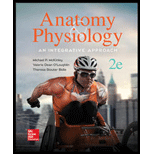
Anatomy & Physiology: An Integrative Approach
2nd Edition
ISBN: 9780078024283
Author: Michael McKinley Dr., Valerie O'Loughlin, Theresa Bidle
Publisher: McGraw-Hill Education
expand_more
expand_more
format_list_bulleted
Question
Chapter 22.6, Problem 23WDYL
Summary Introduction
To determine:
Weather a separate APC is required for B-lymphocyte activation or a B-lymphocyte able to serve the role of an APC.
Concept introduction:
APC is the antigen presenting cell. There are some cells that are having protein present on them. It is a site where the antigen binds. Most of the cells are present in the antigen-presenting site. The antigen presenting includes the major histocompatibility complexes.
Expert Solution & Answer
Want to see the full answer?
Check out a sample textbook solution
Students have asked these similar questions
What are biofertilizers and mention the significance
PCBs and River Otters: Otters in Washington State’s Green-Duwamish River have high levels of polychlorinated biphenyls (PCBs) in their livers. PCBs can bind to the estrogen receptors in animals and disrupt the endocrine system of these otters. The PCBs seem to increase the estrogen to androgen ratio, skewing the ratio toward too much estrogen.
How would increased estrogen affect the river otter population?
Based on your reading of the materials in this unit, what factors can affect fertility in humans?
Explain how each of the factors affecting human fertility that you described can disrupt the human endocrine system to affect reproduction.
Other than oil and alcohol, are there other liquids you could compare to water (that are liquid at room temperature)?
How is water unique compared to these other liquids?
What follow-up experiment would you like to do, and how would you relate it to your life?
Chapter 22 Solutions
Anatomy & Physiology: An Integrative Approach
Ch. 22.1 - Which pathogen must enter a cell to replicate?...Ch. 22.2 - Prob. 2WDYLCh. 22.2 - What is the definition of a cytokine? How are...Ch. 22.2 - Prob. 4WDYLCh. 22.3 - Prob. 5WDYLCh. 22.3 - Prob. 6WDYLCh. 22.3 - How do NK cells accomplish the task of eliminating...Ch. 22.3 - Prob. 8WDYLCh. 22.3 - Prob. 9WDYLCh. 22.3 - Prob. 10WDYL
Ch. 22.3 - Prob. 11WDYLCh. 22.3 - Prob. 12WDYLCh. 22.4 - Prob. 13WDYLCh. 22.4 - What distinguishes a hapten from an antigen?Ch. 22.4 - Prob. 15WDYLCh. 22.4 - Which type of MHC class molecules is found on all...Ch. 22.4 - Prob. 17WDYLCh. 22.5 - Prob. 18WDYLCh. 22.5 - Prob. 19WDYLCh. 22.5 - Prob. 20WDYLCh. 22.6 - Prob. 21WDYLCh. 22.6 - How do cytokines released by helper T-lymphocytes...Ch. 22.6 - Prob. 23WDYLCh. 22.6 - Prob. 24WDYLCh. 22.6 - Prob. 25WDYLCh. 22.7 - Prob. 26WDYLCh. 22.7 - Prob. 27WDYLCh. 22.7 - Prob. 28WDYLCh. 22.8 - Prob. 29WDYLCh. 22.8 - What are the six major functions of antibodies?...Ch. 22.8 - Which subclass of antibodies is most prevalent?...Ch. 22.9 - Prob. 32WDYLCh. 22.9 - Prob. 33WDYLCh. 22.9 - Prob. 34WDYLCh. 22 - _____ 1. All of the following are phagocytic cells...Ch. 22 - _____ 2. This cell releases cytokines to activate...Ch. 22 - _____ 3. This cell is activated by binding...Ch. 22 - _____ 4. These two cells destroy an infected cell...Ch. 22 - _____ 5. All of the following are functions of...Ch. 22 - _____ 6. The four characteristics of adaptive...Ch. 22 - _____ 7. During which process does additional...Ch. 22 - _____ 8. This chemical is released by...Ch. 22 - _____ 9. The correct sequence of the major events...Ch. 22 - _____ 10. Two of the major actions of complement...Ch. 22 - Compare the general characteristics of innate...Ch. 22 - Define the inflammatory response, and explain its...Ch. 22 - Describe an antigen.Ch. 22 - Describe class I and class II MHC molecules, and...Ch. 22 - Prob. 15DYKBCh. 22 - Prob. 16DYKBCh. 22 - Explain the general function of cytotoxic...Ch. 22 - Describe both the function of antibodies and...Ch. 22 - There are two branches of adaptive immunity:...Ch. 22 - Prob. 20DYKBCh. 22 - Prob. 1CALCh. 22 - Prob. 2CALCh. 22 - Prob. 3CALCh. 22 - Prob. 4CALCh. 22 - Prob. 5CALCh. 22 - Prob. 1CSLCh. 22 - Prob. 2CSLCh. 22 - Prob. 3CSL
Knowledge Booster
Similar questions
- Selection of Traits What adaptations do scavengers have for locating and feeding on prey? What adaptations do predators have for capturing and consuming prey?arrow_forwardCompetition Between Species What natural processes limit populations from growing too large? What are some resources organisms can compete over in their natural habitat?arrow_forwardSpecies Interactions Explain how predators, prey and scavengers interact. Explain whether predators and scavengers are necessary or beneficial for an ecosystem.arrow_forward
- magine that you are conducting research on fruit type and seed dispersal. You submitted a paper to a peer-reviewed journal that addresses the factors that impact fruit type and seed dispersal mechanisms in plants of Central America. The editor of the journal communicates that your paper may be published if you make ‘minor revisions’ to the document. Describe two characteristics that you would expect in seeds that are dispersed by the wind. Contrast this with what you would expect for seeds that are gathered, buried or eaten by animals, and explain why they are different. (Editor’s note: Providing this information in your discussion will help readers to consider the significance of the research).arrow_forwardWhat is the difference between Uniporters, Symporters and Antiporters? Which of these are examples of active transport?arrow_forwardWhat are coupled transporters?arrow_forward
- How do histamine and prostaglandins help in the mobilization of leukocytes to an injury site? What are chemotactic factors? How do they affect inflammation process?arrow_forwardCompare and contrast neutrophils and macrophages. Describe two ways they are different and two ways they are similar.arrow_forwardDescribe the effects of three cytokines (not involved in the initial inflammation response). What cells release them?arrow_forward
arrow_back_ios
SEE MORE QUESTIONS
arrow_forward_ios
Recommended textbooks for you
 Human Biology (MindTap Course List)BiologyISBN:9781305112100Author:Cecie Starr, Beverly McMillanPublisher:Cengage Learning
Human Biology (MindTap Course List)BiologyISBN:9781305112100Author:Cecie Starr, Beverly McMillanPublisher:Cengage Learning

Human Biology (MindTap Course List)
Biology
ISBN:9781305112100
Author:Cecie Starr, Beverly McMillan
Publisher:Cengage Learning